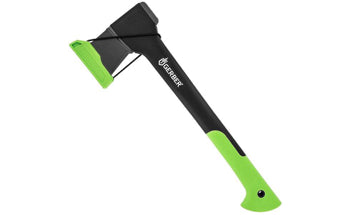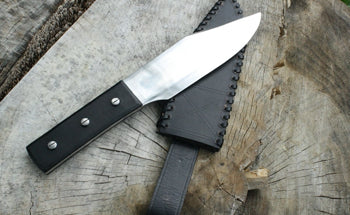Overview of Heat Treatment
In order for your tomahawk to last and perform as designed, it will be necessary that the steel be heat treated and tempered, regardless of the type of carbon steel that you select. Heat-treating hardens the steel, while tempering reduces the brittleness of the steel. Basically, hardening of the steel involves heating the tomahawk head to a very high temperature and then cooling it off quickly and evenly. In contrast, tempering involves heating the steel slowly to a lower temperature and then letting it “bake” and then cooling down naturally. It is not necessary to heat treat and temper brass tomahawk heads
What You Will Need to Heat Treat
In order to get started, you are going to need to the following items: safety glasses, heavy duty gloves, “Vise Grips” pliers, a deep pan, motor oil, a magnet, approximately 18” of heavy duty wire at least 1/8” in diameter, a heat source such as a propane torch or an acetylene gas torch, rags and a standard oven. The final thing needed is a clear space to work safely. The most critical item is the heat source as it must be capable of heating the tomahawk head to very high temperature evenly.
Due to the size and shape of the heads, as well as the limitations on many consumers heat sources, it will be necessary to treat the tomahawk head in several sections. First treat the head, then the hammer and then the neck of the head.
Steps for Heat Treating
Once everything is gathered, the steps are as follows:
- Fill the pan with oil, which should be at room temperature.
- Run one end of the wire thru the hole in the tomahawk. Twist both ends of the wire together; which will create a loop that will hold the tomahawk head.
- Light the torch and secure it in a manner so that it will not to fall over.
- Once that is done, put on the safety glasses and gloves
- Then using the “Vise Grips” pliers, pick up the tomahawk head by one end of the wire. It is important to have a secure, yet, comfortable grip on the wire at this point.
- Place the area of the head being treated within ½” of the flame and move it continuously around the area until is bright red. It is critical to heat the head evenly with particular attention being paid to the “axe” portion of the head. It is recommended that the “axe” be heated along the spine and not of the faces of the “axe”. Failure to heat the tomahawk head evenly, can result if the steel in the head to warp, which will ruin the head. It is critical that the ‘axe” remain straight or the tomahawk will not be suitable for throwing.
- In order to see if the head is hot enough, place the heated portion of the head next to the magnet to see if it is attracted to the head. Steel looses its magnetic capabilities when heated to high temperatures. If the magnet is still attracted to the heated steel, then the head is not hot enough. If this is the case, continue to heat the head. If the magnet is not attracted to the area heated, then it is hot enough and ready for step 8.
- Once the portion of the head is “red hot” and is hot enough as determined using the magnet test, place the tomahawk head into the pan ofoilto cool it off. Be sure to move the head around is the oil as it is cooling. Be sure to keep your face and hand clear of the oil pan, as it is likely that flames will come out of the pan once the head is inserted.
- After the head is cool, wipe the area down that was treated with a rag, removing the oil.
- Next repeat steps 6-9 until the entire head has been heat-treated.Once the entire head has been heat treated, the next step is to temper the steel, because the steel in the tomahawk head, while very hard, is also brittle at this point.
- Using a standard oven, heat the oven to 350 degrees using the bake settings.
- Place the tomahawk head into the oven and let it “bake” for 2 hours.
- After 2 hours, turn off the oven.
- Leave the tomahawk head in the oven until the head cools naturally.
- After the tomahawk head is cool, the head is ready to be polished.
- Once polished, the handle is inserted and the head is ready for use.
- During the cleanup process be sure to dispose of the oil in a responsible manner, which will not damage the environment.
A properly heated treated and tempered tomahawk head will hold an edge, as well as being strong and durable. If properly cared for, the tomahawk head will last for a lifetime and will be a great tool to leave to future generations.




















